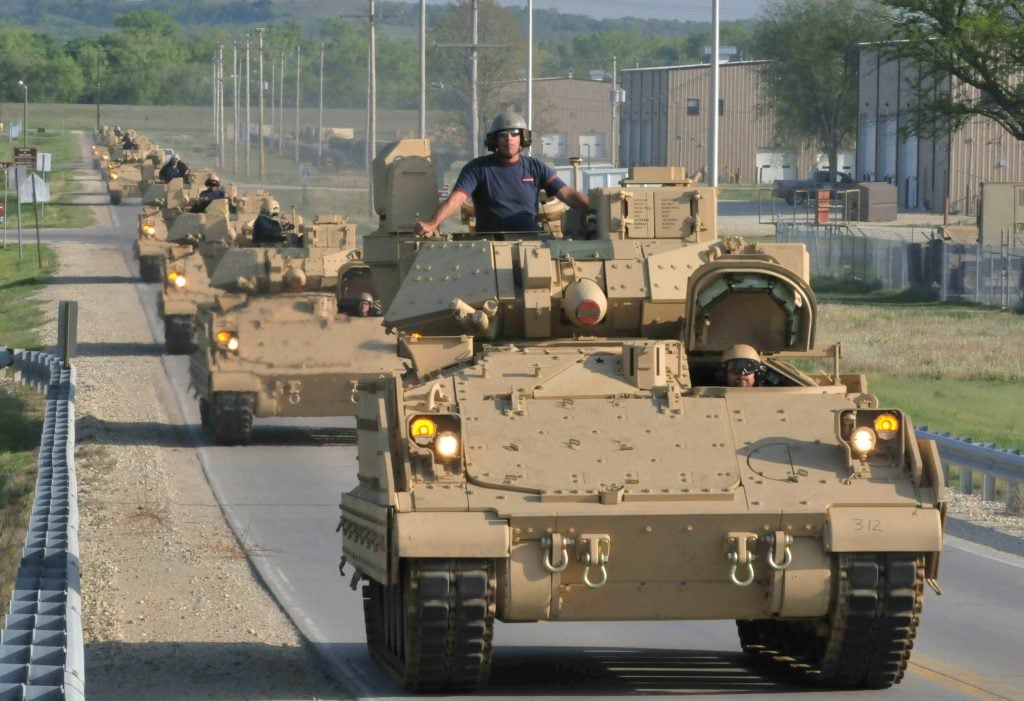
Civilian personnel deliver the latest Bradley model, the M2A3, to Fort Riley, KS
WASHINGTON: For the third time in 11 years, the Army’s attempt to replace the 1980s-vintage M2 Bradley ran afoul of the age-old tradeoff between armor and mobility, several knowledgeable sources tell Breaking Defense.

Bruce Jette
The General Dynamics prototype for the Optionally Manned Fighting Vehicle – the only competitor left after other companies bowed out or were disqualified – was too heavy to meet the Army’s requirement that a single Air Force C-17 cargo jet could carry two complete OMFVs to a war zone, we’re told. But the vehicle had to be that heavy, GD’s defenders say, to meet the Army’s requirement for armor protection.
Now, the Army hasn’t officially said why it cancelled the current OMFV contract. Senior leaders – Chief of Staff, Gen. James McConville; the four-star chief of Army Futures Command, Gen. Mike Murray; and the civilian Army Acquisition Executive, Assistant Secretary Bruce Jette – have all publicly acknowledged that the requirements and timeline were “aggressive.” (Yes, all three men used the same word). Jette was the most specific, telling reporters that one vendor – which, from the context of his remark, could only be GD – did not meet all the requirements, but he wouldn’t say which requirements weren’t met.
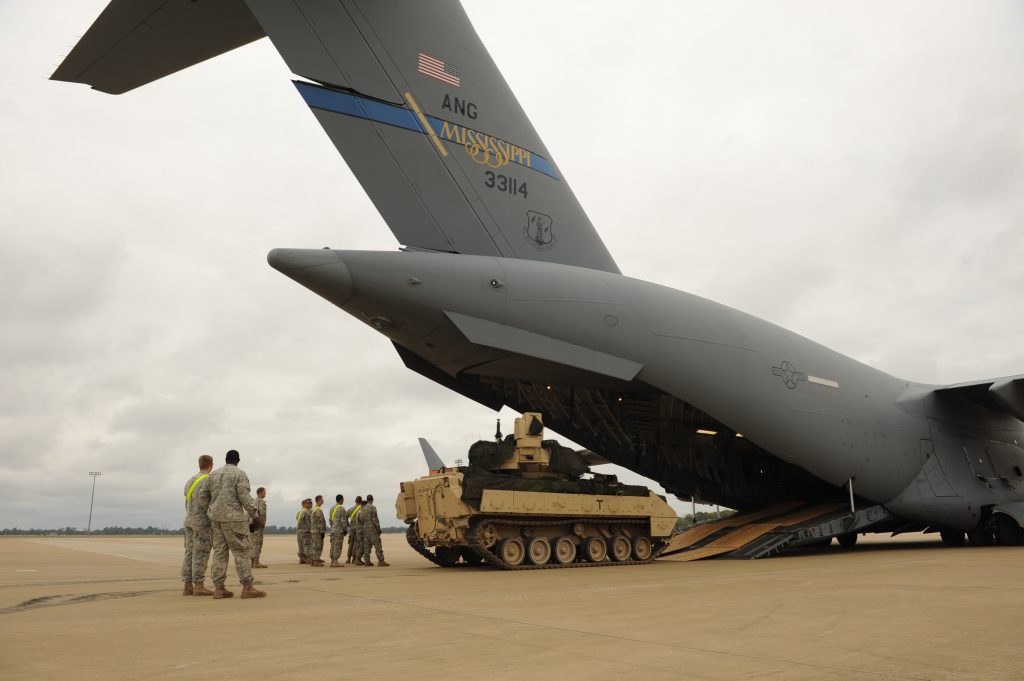
An Army M2 Bradley drives aboard an Air National Guard C-17 transport.
So, while we generally avoid writing a story based solely on anonymous sources, in this case we decided their track records (which we can’t tell you about) were so good and the subject was so important that it was worth going ahead.
“Industry told the Army the schedule was ‘unobtainium,’ but they elected to proceed anyway,” one source told us: That’s why the other potential competitors dropped out, seeing the requirements as too hard to meet. In particular, the source said, “industry needs more time to evaluate the trade [offs] associated with achieving the weight requirement.”
With more time, industry might have been able to refine the design further to reduce weight, redesign major components to be lighter, or possibly – and this one is a stretch – even invent new stronger, lighter materials. But on the schedule the Army demanded, another source told us, reaching the minimum allowable protection without exceeding the maximum allowable weight was physically impossible.
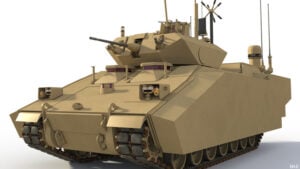
BAE’s design for the cancelled Ground Combat Vehicle
Why This Keeps Happening
The Army’s been down this road before and stalled out in similar ways. The Ground Combat Vehicle was too heavy, the Future Combat Systems vehicles were too light; “just right” still seems elusive.
In 2009, Defense Secretary Bob Gates cancelled the Future Combat Systems program, whose BAE-designed Manned Ground Vehicles – including a Bradley replacement – had been designed to such strict weight limits that they lacked adequate armor. The Army had initially asked for the FCS vehicles to come in under 20 tons so one could fit aboard an Air Force C-130 turboprop transport. After that figure proved unfeasible, and the Air Force pointed out a C-130 couldn’t actually carry 20 tons any tactically useful distance, the weight crept up to 26 tons, but the added armor wasn’t enough to satisfy Gates’ concerns about roadside bombs, then taking a devastating toll on US soldiers in Iraq.
Four years later, amidst tightening budgets, the Army itself gave up on the Ground Combat Vehicle, another Bradley replacement, after strict requirements for armor protection drove both competing designs – from General Dynamics and BAE Systems – into the 56-70 ton range, depending on the level of modular add-on armor bolted onto the basic chassis. (A much-publicized Governmental Accountability Office study claimed GCV could reach 84 tons, but that was a projection for future growth, not an actual design).

The Army’s Future Combat Systems (FCS) program, cancelled in 2009.
Not quite nine months ago, after getting initial feedback from industry on the Optionally Manned Fighting Vehicle, the Army made the tough call to reduce its protection requirements somewhat to make it possible to fit two OMFVs on a C-17. If our sources are correct, however, it didn’t reduce the armor requirement enough for General Dynamics to achieve the weight goal.
One source says that two of the General Dynamics vehicles would fit on a C-17 if you removed its modular armor. The add-on armor kit could then be shipped to the war zone on a separate flight and installed, or simply left off if intelligence was sure the enemy lacked heavy weapons. But the requirements didn’t allow for that compromise, and the Army wasn’t willing to waive them, the source said, because officers feared a vehicle in the less-armored configuration could get troops killed.
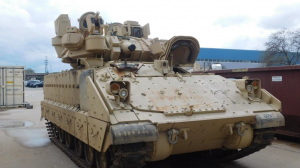
Iron Fist-Light Active Protection System installed on a US Army M2 Bradley Infantry Fighting Vehicle. (Rada photo)
Other Options
Now, there are ways to protect a vehicle besides heavy passive armor. Some IEDs in Iraq were big enough to cripple a 70-ton M1 Abrams. Russian tanks get by with much lighter passive armor covered by a layer of so-called reactive armor, which explodes outwards when hit, blasting incoming warheads before they can penetrate. Both Russia and Israel have fielded, and the US Army is urgently acquiring, Active Protection Systems that shoot down incoming projectiles.
The problem with both reactive armor and active protection is that they’re only proven effective against explosive warheads, like those found on anti-tank missiles. They’re much less useful against solid shells, and while no missile ever fielded can use those, a tank’s main gun can fling solid shot with such force that it penetrates armor through sheer concentrated kinetic energy.
(Protecting against roadside bombs and land mines is yet another design issue, because they explode from underneath, but it’s no longer the all-consuming question it once ways. Advances in suspension, blast-deflecting hull shapes, and shock absorption for the crew have made even the four-wheeled Joint Light Tactical Vehicle remarkably IED-resistant and pretty comfortable).
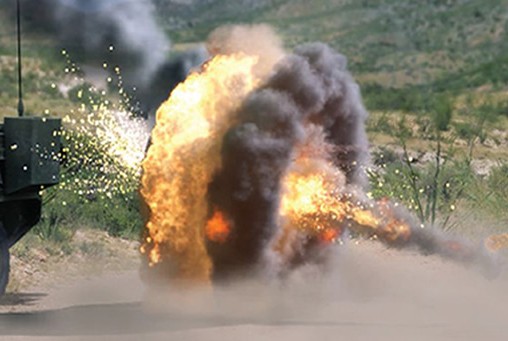
Raytheon Quick Kill Active Protection System
If the Army were willing to take the risk of relying more on active protection systems, or give industry more time to improve active protection technology, it could reduce its requirements for heavy passive armor. Or the Army could remove the soldiers from its combat vehicles entirely and operate them with a mix of automation and remote control, which would make crew protection a moot point. In fact, the service is investing in lightly-armored and relatively expendable Robotic Combat Vehicles – but it still sees those unmanned machines as adjuncts to humans, not replacements. As long as the Army puts soldiers on the battlefield, it will want the vehicles that carry them to be well-protected.
Alternatively, the Army could drop its air transport requirements and accept a much heavier vehicle. Israel has already done this with its Namer troop carrier, a modified Merkava heavy tank, but then the Israel army doesn’t plan to fight anywhere far away. The US, by contrast, routinely intervenes overseas and has dismantled many of its Cold War bases around the world. Air transport is a limited commodity anyway, and war plans assume most heavy equipment will either arrive by sea or be pre-positioned in warehouses on allied territory. But the Army really wants to have the option to send at least some armored vehicles by air in a crisis.
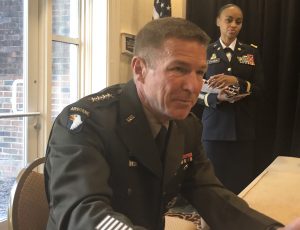
Gen. James McConville
If the Army won’t give ground on either protection or transportability, then it faces a different dilemma: They need to either give industry more time to invent something revolutionary, or accept a merely evolutionary improvement.
“We’re going to reset the requirements, we’re going to reset the acquisition strategy and timeline,” Gen. McConville said about OMFV on Tuesday. But, when he discussed Army modernization overall, he repeatedly emphasized that “we need transformational change, not incremental improvements.
“Transformational change is how we get overmatch and how we get dominance in the future,” the Chief of Staff said. “We aren’t looking for longer cords for our phones or faster horses for our cavalry.”
Move over FARA: General Atomics pitching new Gray Eagle version for armed scout mission
General Atomics will also showcase its Mojave demonstrator for the first time during the Army Aviation Association of America conference in Denver, a company spokesman said.


























